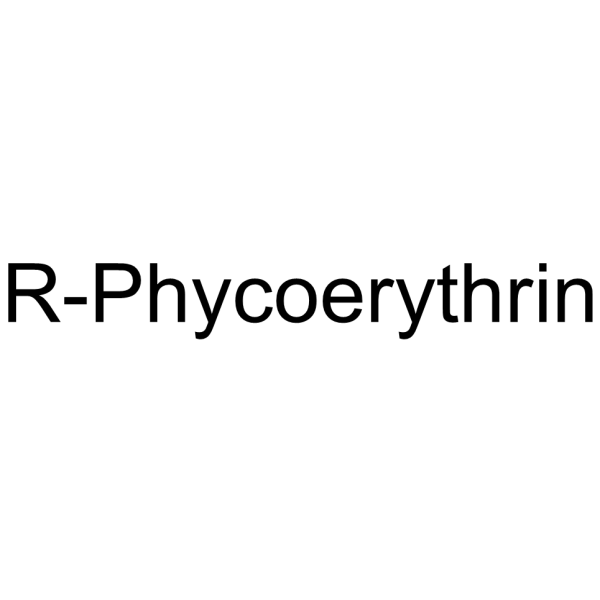R-Phycoerythrin

R-Phycoerythrin structure
|
Common Name | R-Phycoerythrin | ||
|---|---|---|---|---|
| CAS Number | 11016-17-4 | Molecular Weight | N/A | |
| Density | N/A | Boiling Point | N/A | |
| Molecular Formula | N/A | Melting Point | N/A | |
| MSDS | USA | Flash Point | N/A | |
| Symbol |


GHS06, GHS09 |
Signal Word | Danger | |
|
Direct differentiation of A-ring single attachment versus A- and D-ring double attachment of phycoerythrobilin chromophores to phycobiliproteins using MALDI mass spectrometry.
J. Mass Spectrom. 48(2) , 187-92, (2013) Bilin chromophore attachment to phycobiliproteins is an enzyme-catalyzed post-translational modification process. Bilin-lyases attach a bilin chromophore to their cognate protein through a thioether bond between the chromophore and a cysteine moiety. Bilin ch... |
|
|
Salinity impacts photosynthetic pigmentation and cellular morphology changes by distinct mechanisms in Fremyella diplosiphon.
Biochem. Biophys. Res. Commun. 433(1) , 84-9, (2013) Fremyella diplosiphon is a freshwater cyanobacterium that exhibits complementary chromatic adaptation (CCA), which allows the organism to alter its pigmentation and cellular morphology to maximally harvest available green light (GL) and red light (RL) at diff... |
|
|
A minimal phycobilisome: fusion and chromophorylation of the truncated core-membrane linker and phycocyanin.
Biochim. Biophys. Acta 1817(7) , 1030-6, (2012) Phycobilisomes, the light-harvesting antennas in cyanobacteria and red algae, consist of an allophycocyanin core that is attached to the membrane via a core-membrane linker, and rods comprised of phycocyanin and often also phycoerythrin or phycoerythrocyanin.... |
|
|
Immunomodulatory properties of the protein fraction from Phorphyra columbina.
J. Agric. Food Chem. 60(33) , 8146-54, (2012) The phycobiliproteins from Rhodophyta , R-phycoerythrin (R-PE) and C-phycocyanin (C-PC), have been shown to exert immunomodulatory effects. This study evaluated the effects of a Phorphyra columbina protein fraction (PF) and R-PE and C-PC on rat primary spleno... |
|
|
Phycoerythrin evolution and diversification of spectral phenotype in marineSynechococcusand related picocyanobacteria
Mol. Phylogenet. Evol. 64(3) , 381-92, (2012) Graphical abstract |
|
|
T/B ratio does not reflect levels of ZAP70 expression in clonal CLL B-cells due to ZAP70 overexpression in patient T-cells.
Cytometry B. Clin. Cytom. 84(2) , 125-32, (2013) Flow cytometry is the reference technique for assessing ZAP70 expression, a marker of poor prognosis in CLL. One of the most common methods is to assess ZAP70 levels in CLL cells by calculating the ratio between ZAP70 mean fluorescence intensities (MFIs) in r... |
|
|
Limitations of Electronic Energy Transfer in the Determination of Lipid Nanodomain Sizes
Biophys. J. 101(11) , L60-2, (2011) Even though superresolution microscopy indicates that size of plasma membrane rafts is <20 nm, those structures have never been observed. Förster resonance energy transfer (FRET) is therefore still the most powerful optical method for characterization of such... |
|
|
3D coupling of fibronectin fibril arrangement with topology of ventral plasma membrane.
Cell. Comm. Adhes. 19(2) , 17-23, (2012) Interaction of integrins with extracellular matrices is essential for cell adhesion to substrata. Ventral surfaces of fibroblasts adhering to flat substrata are not flat but have uneven 3D topology. However, spatial relationship between the topology of the ve... |
|
|
Microparticle detection in platelet products by three different methods.
Transfusion 53(1) , 156-66, (2013) Standardization of platelet-derived microparticle (PMP) enumeration by flow cytometry (FCM) is limited due to its intrinsic characteristics. Because of high clinical relevance of microparticle (MP) detection, standardization of MP assays is required.This pros... |
|
|
Spatio-temporal niche partitioning of closely related picocyanobacteria clades and phycocyanin pigment types in Lake Constance (Germany).
FEMS Microbiol. Ecol. 80(2) , 488-500, (2012) We found that the clade-specific abundance dynamics of Synechococcus type picocyanobacteria in the pelagic and littoral zone macro-habitats of Lake Constance (Germany) challenge the hypothesis of a regular annual succession of picocyanobacteria genotypes in t... |